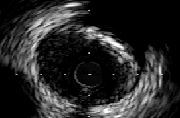 Calcified atherosclerotic plaque in a coronary artery.
Calcified atherosclerotic plaque in a coronary artery.
 Calcified atherosclerotic plaque in a coronary artery.
Calcified atherosclerotic plaque in a coronary artery.
Circulation 1995 Mar 15;91(6):1676-88 The hypothesis that systemic anticoagulation is not necessary when adequate stent expansion is achieved was prospectively evaluated. Patients with adequate stent expansion confirmed by IVUS were treated only with antiplatelet therapy (either ticlopidine for 1 month with short-term aspirin for 5 days or only aspirin) after the procedure. The Palmaz-Schatz stent can be safely inserted in coronary arteries without subsequent anticoagulation provided that stent expansion is ade quate and there are no other flow-limiting lesions present. The use of high-pressure final balloon dilatations and confirmation of adequate stent expansion by intravascular ultrasound provide assurance that anticoagulation therapy can be safely omitted. This technique significantly reduces hospital time and vascular complications and has a low stent thrombosis rate.
Circulation 1995 Apr 1;91(7):1959-65 IVUS detected coronary artery calcium significantly more often than standard angiography. Although angiography is moderately sensitive for the detection of extensive lesion calcium (sensitivity, 60% and 85%for three- and four-quadrant calcium, respectively), it is less sensitive for the presence of milder degrees.
J Am Coll Cardiol 1995 May;25(6):1310-7 Patients with syndrome X have abnormal coronary arteries by IVUS. There are three distinct morphologic groups: normal coronary arteries, atheromatous plaque and intimal thickening. Exercise vasomotion is normal in patients with syndrome X who have normal coronary arteries by ultrasound. Patients with abnormal arteries (plaque or intimal thickening) have an abnormal (constrictive) response to exercise. Propranolol loading attenuates vasoreactivity in all subgroups, suggesting divergent therapeutic utility.
Z Kardiol 1995 Mar;84(3):205-15 IVUS was used to assess the risk of interventional dissections. Size of the balloon in relation to vessel cross-sectional area, small total vessel cross-sectional area and eccentric stenosis morphology in the preinterventional IVUS study predispose to an increased risk of dissection.
Br J Radiol 1995 Feb;68(806):110-5 Echogenicities of the plaques and morphological alterations in the arterial walls produced by atherectomy were evaluated. The two-layered appearance of inner fibrous intimal thickening with proliferation of smooth muscle cells and outer residual collagen-rich plaque. The deep cut surfaces were shown as concave U-shaped defects. Medial tissues were present in all cases where IVUS demonstrated the disruption of a thin hyperechoic layer of the internal elastic lamina.
Am Heart J 1995 Apr;129(4):726-32 reported the contribution of endothelium-derived nitric oxide to coronary arterial distensibility based on the fact that reduced epicardial coronary arterial distensibility associated with early atherosclerosis may be mediated in part by reduced nitric oxide (NO) release. The authors examined the effect of intracoronary N omega nitro-L-arginine methyl ester (L-NAME), an inhibitor of NO synthase, and L-arginine, its natural substrate, on the circumflex artery. They also used intracoronary acetylcholine to examine the effect of pharmacologically induced NO release on coronary distensibility.
Am Heart J 1995 Mar;129(3):593-8 Ultrasound-guided directional atherectomy is technically feasible and may aid in achieving maximal plaque debulking and reduce the amount of subintimal injury.
Circulation 1995 Mar 1;91(5):1375-80, Intracoronary ultrasound showed that coronary ectasia is more prevalent in patients with familial hypercholesterolemia than in other patients with coronary atherosclerosis. There was a strong inverse association with HDL cholesterol levels suggesting that the disordered lipoprotein metabolism may predispose patients to aneurysmal coronary artery disease.
Back to E-chocardiography Home Page.

The contents and links on this page were last verified on December 24, 1998.